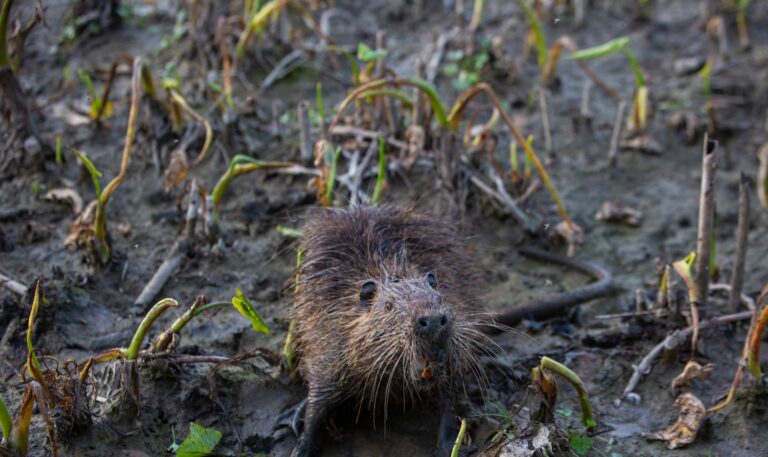
The U.S. Fish and Wildlife Service teamed up with several agencies — including the U.S. Department of Agriculture’s Wildlife Services and the Maryland Department of Natural Resources — along with 700 landowners and enlisted trained trappers and wildlife experts to catch and kill about 14,000 invasive nutria that had proliferated in the Delmarva area, a 170-mile stretch that crosses the three states.
Now, seven years after the last nutria was caught and killed, experts have officially declared the animals gone — at least for now. There are worries that nutria could creep back into parts of central Maryland from points along the James River in southern Virginia, where they have been spotted.
Still, the eradication effort stands out as a wildlife feat, experts said, because of its large scale and success in eliminating such a pesky, destructive rodent.
“It’s a rare success story for an invasive species,” said Trevor A. Michaels, who headed the nutria eradication project for USDA Wildlife Services. “Nutria are notoriously hard to deal with, and it’s very hard to get rid of them.”
Known formally as Myocastor coypus and commonly called the “menace of the marsh,” nutria are bad for ecosystems. They weigh about 20 pounds and live in burrows along rivers, lakes and streams in marshlands, and unlike muskrats that only eat the tops of plants, nutria are notorious for devouring entire plants — stems and roots.
Without plant roots, the marsh eventually won’t have enough food and habitat for other animals, including birds such as egrets and herons, fish, oysters and crabs. Plus, plant roots help prevent erosion in a marsh and act as a barrier to keep storm surges from coming too far inland, wildlife biologists said. With a growing nutria population, plus sea-level rise, wetlands along the Delmarva were at increased risk.
At one point, experts said, there may have been some economic benefit to nutria in the Mid-Atlantic, but because they’re not native to the area, they caused too much environmental damage.
“Nutria were destroying plants that are crucial to the survival of marshes, and the plants couldn’t replenish themselves fast enough,” said Marcia Pradines Long, the refuge manager for the U.S. Fish and Wildlife Service at Blackwater National Wildlife Refuge, near Cambridge, Md.
“Once the grasses are gone,” she said, “the marshes disappear, and then so do all the species living there.”
Nutria severely damaged marshlands along the Delmarva Peninsula, which are important habitats for waterfowl, spawning grounds for striped bass and blue crab, and breeding areas for at-risk or endangered species including the salt marsh sparrow and the black rail.
Originally from South America, nutria were introduced into the Delmarva area in the 1940s and were bred for their fur and meat. They’re also problematic in parts of North Carolina and Louisiana. Because they’re easy to breed, trapping and harvesting them for their fur was once lucrative.
But when nutria fur fell out of favor, many were released or escaped into the wild. Trappers had little incentive to harvest them, experts said, but because they reproduce fast and have no natural predators in the region, their population exploded. Nutria breed about three times a year, and a female usually has up to 14 juveniles in one litter.
“They bred so efficiently, and there’s no natural predators in our system to remove them, so there was nothing combating their growth,” Michaels said. “They were only dying through old age or in extremely cold winters.”
They multiplied and laid waste to about 5,000 acres of marshland at Blackwater.
Nutria damage in a marsh is easy to spot. Michaels said it looks like a field that’s been hit by a rototiller. A 2004 study found that nutria caused $5.8 million of environmental, economic and other losses in Maryland’s Chesapeake Bay area.
In 2002, experts launched a long-term plan to tackle the problem along the Delmarva. They used highly trained dogs to track the rodents by detecting them through their scat, then set traps to catch and kill them. Once the bulk of them were killed, officials wanted to make sure they hadn’t missed any smaller populations, so they used tracking collars — something that had not been done before in battling nutria.
“They’re very gregarious, so they’ll seek out one another in low populations,” Michaels said. They caught some nutria alive, spayed and neutered them, then outfitted them with GPS tracking collars.
“They did exactly what we were hoping they would do,” Michaels said. “They led us to smaller populations that we had missed.”
Saving D.C.’s endangered species — the Hay’s Spring amphipod
By 2015, wildlife biologists said the last known nutria in the Delmarva area was captured and killed. Since then, they monitored the area to be sure nutria were gone before declaring them officially eradicated from the Delmarva Peninsula this fall.
However, after the success on the eastern side of the Chesapeake Bay, there’s now concern that nutria — recently spotted in the Tidewater area of Virginia — could come up the western side of the bay and reinvade Maryland, said Scott Barras, the state director of USDA’s Wildlife Services program in Virginia. So there’s a push to continue a similar large eradication effort in Virginia.
“You’ve been working hard to eradicate them on one side, and then you could get a left hook from them on the other side,” Barras said.
Michaels said a reinfestation by way of Virginia would be bad: “We devoted 20 years and $30 million to get rid of them. … We don’t want to lose that win.”